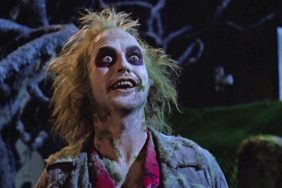30. Dawn of the Dead (dir. Zack Snyder, 2004)

Universal Pictures
Viewed as a remake of George A. Romero’s satirical 1978 blood opera, Zack Snyder’s same-named zombie shocker is a failure. But taken as a simple, straightforward action horror film, Dawn of the Dead is a visceral rush; a serious, violent and often horrifyingly suspenseful shock to the senses that moves just as quickly as its sprinting, screaming ghouls. Canadian actress Sarah Polley is excellent in the role of a nurse whose life is jettisoned into hell when a mysterious disease spreads like wildfire, turning the populace into rabid zombies. Like in the original film, she and a gaggle of survivors find sanctuary in a shopping mall and attempt to ride out the disaster. That’s where the connection to Romero stops however and Dawn finds its own way. The success of this film and the first Resident film are what propelled the current and seemingly unyielding zombie film craze. ~ Chris Alexander
29. The Ring (dir. Gore Verbinski, 2002)

DreamWorks Pictures
The Ring was the first in a series of modern-day American remakes of Japanese horror films, and it still stands out as one of the best. Urban legends, child abuse, and ghosts, along with special effects that would later become the standard for ghost stories, made The Ring a terrifying box office success that scared grown men. Samara has entered the pop culture lexicon. She may not always be known by name, but her stained white shirtdress and stringy black hair covering her face have become the go-to look for “scary girl ghosts.” Director Gore Verbinski took what could have been a bland ghost story and made it haunting and atmospheric. ~ Alyse Wax
28. 28 Days Later (dir. Danny Boyle, 2002)

Fox Searchlight Pictures
Shot on cheap, consumer-grade digital cameras, Danny Boyle managed to create a new aesthetic for horror movies, making them seem immediate and modern, rather than classical and stagey. He also updated zombies for the modern age, turning them into wrathful sprinters rather than shambling drones. The result was not only scary, but seemed to officially update the genre. ~ Witney Seibold
27. Grindhouse (dirs. Robert Rodriguez, Quentin Tarantino, et al, 2007)

Dimension Films
Not so much a film as a roller coaster, this ambitious double-feature presentation from Robert Rodriguez and Quentin Tarantino sent audiences crashing headlong into thrills and chills. The fake trailers are hilarious, but what really matters is how Rodriguez and Tarantino approached the same prompt (“Make your own grindhouse movie!”) in different, fascinating ways. Rodriguez made the epic zombie movie that 1970s filmmakers could have only fantasized about, and Tarantino made a car chase movie that actually could have been produced decades ago, and still outdid the originals. ~ William Bibbiani
26. Orphan (dir. Jaume Collet-Serra, 2009)

Warner Bros. Pictures
Critic Gene Siskel had a pet peeve about watching children in peril in movies. He would have loathed Jaume Collet-Serra’s Orphan, a film about a diabolical 9-year-old adoptee who terrorizes her poor adopted mother and, in one deliciously disgusting scene, attempts to seduce her adopted father. Orphan, unlike so many horror films of the modern age, is not afraid to be irresponsible. ~ Witney Seibold
25. Paranormal Activity (dir. Oren Peli, 2007)

Paramount Pictures
Ignore the half-assed found-footage knockoffs that Paranormal Activity wrought (if you can). The original film is a terrifyingly universal horror tale, about a young couple being stalked by a demonic entity, and dealing with this plight in ways that – demon or no demon – probably meant that their relationship was always doomed. Director Oren Peli’s skillful use of repeated images – like a woman watching her boyfriend sleep, for hours – forces the audience to scour the screen for subtle clues as to where the next scare will come from. Then he manages to surprise and shock us anyway. ~ William Bibbiani
24. Antichrist (dir. Lars Von Trier, 2009)

IFC Films
A landmark horror film. In it, Danish enfant terrible Lars Von Trier drags his favorite actress Charlotte Gainsbourg to Hell and his audience along with her. Gainsbourg dives in with another fearless performance as a woman whose child falls to his death while she is engaged in explicitly shot sex with her husband (Willem Dafoe). Later, the mourning couple attempt to heal by retreat to the woods where they both try to fuck the pain away. But while he urges her to collect herself and move forward, she keeps retreating into a psychological abyss of witchery, erotic hysteria and eventually ultra violence. There are moments of Antichrist that, once seen, cannot be unseen. ~ Chris Alexander
23. Insidious (dir. James Wan, 2011)

FilmDistrict
Insidious brought about a renaissance in intelligent, scary horror that wasn’t reliant on being a sequel or a remake. Audiences ate it up, making it the most profitable film of 2011 and securing director James Wan as a master of the horror genre. Insidious doesn’t depend on gore. It doesn’t shy away from it, but Wan is able to deliver tension and subtle scares that balances well with the comedy of Tucker and Specs (Angus Sampson and screenwriter Leigh Whannell). ~ Alyse Wax
22. American Mary (dirs. Jen & Sylvia Soska, 2012)

IndustryWorks Pictures
The Soska Sisters sink us deep into the world of underground, illegal surgery in American Mary, a film that manages to celebrate its counterculture while simultaneously acknowledging how disturbing it is. Katharine Isabelle (perfectly cast) plays a med student who traverses the dark path from victim to hero to villain, performs disturbing operations that mold her clients into anything they want to become, as she herself develops the skill set necessary to transform her enemies in more gruesome ways. A complex character study in a fascinating environment, American Mary is one of the most distinctive and rewarding horror films in recent memory. ~ William Bibbiani
21. The Descent (dir. Neil Marshall, 2005)

LionsGate
There are monsters in Neil Marshall’s subterranean shocker, but long before they even show up he’s got us right where he wants us: in the dark, claustrophobic, scared out of our minds. A group of female spelunkers become trapped in a series of unexplored caverns. Low on light and with no hope of rescue they trudge slowly forward, into eery crevasses, and towards their certain doom. The atmosphere oozes in The Descent… and then the monsters come. ~ William Bibbiani
Next: #20-11








